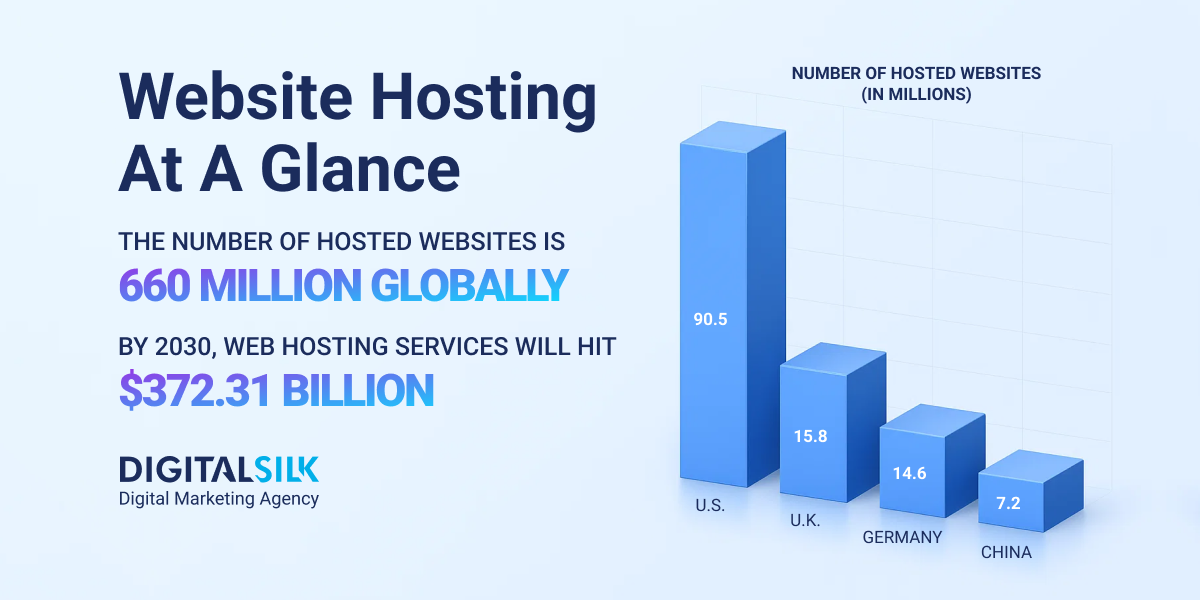Web Hosting Statistics: Key Highlights
-
The global web hosting market is projected to grow from $126.4 billion in 2024 to $372.31 billion by 2030, at a CAGR of 13.62%.
-
Amazon, Namecheap and Cloudflare lead U.S. hosting by share, while Microsoft Azure is trusted by 95% of Fortune 500 companies.
-
Downtime now costs large organizations an average of $9.000 per minute, making hosting reliability a direct financial priority.
Behind every high-performing website is a hosting strategy designed to capture every millisecond of buyer intent.
Out of 1.1 billion websites in the world, over 660 million are hosted globally and 90.5 million are in the U.S.
These platforms are competing for faster load times, consistent uptime and scalable capacity during peak demand, companies pulling ahead are turning infrastructure into a measurable competitive advantage.
Outages, delays and security lapses directly translate to lost revenue, damaged customer trust and shrinking market share as faster competitors seize the opportunity.
In this post, we’ll uncover 50 web hosting statistics that show how leading businesses are turning hosting performance into business growth.
General Web Hosting Trends
Website hosting has become a high-stakes operational priority, where the cost of performance issues can escalate into significant financial losses.
Companies are increasing their infrastructure investments to keep up with rapid market expansion, while also navigating the pressure of rising efficiency demands.
The website hosting stats below reveal how spending patterns, market leadership and downtime risks are reshaping strategic decisions across industries.
- The worldwide web hosting services market was valued at approximately $126.4 billion in 2024.
- The web hosting industry is on track to experience notable expansion over the coming years, with projected earnings reaching $196.62 billion in 2025.
- The market is forecasted to grow at a compound annual growth rate (CAGR) of 13.62%, reaching a total market volume of $372.31 billion by 2030.
- The United States is set to achieve the highest national revenue in the sector, with $73.71 billion projected for 2025.
- The average spending per employee within the web hosting sector is estimated to be $52.44 in 2025, reflecting the industry’s strategic investments and operational efficiency levels.
- The average cost of downtime for large organizations has climbed to $9.000 per minute.
- In 2024, there were 11 million websites using the .org domain.
What These Numbers Mean For You
- Plan for hosting scalability. Rapid market growth will demand infrastructure that can handle higher traffic and data loads without disruptions.
- Mitigate downtime risks. Downtime is now a major financial threat, requiring investments in monitoring, redundancy and rapid response protocols.
- Leverage hosting market competition. With aggressive industry growth, companies can renegotiate better hosting terms and adopt newer, scalable technologies.
Top Hosting Providers Statistics
The choice of hosting provider directly affects website performance, impacting load times, uptime reliability and the ability to convert visitors and generate leads.
Leading companies like Amazon, Microsoft Azure and Google Cloud are not just battling for volume but for high-performance clients, as enterprise trust and inactive domains shape a fragmented landscape.
The web hosting statistics below highlight provider dominance, usage trends among high-traffic websites and the platforms businesses rely on to balance scale, reliability and strategic infrastructure control.
- As of July 2025, Amazon is the most popular web hosting provider worldwide, with a 12% market share.
- 29% of hosted websites are classified as “domain not resolving”, meaning they are inactive or no longer accessible.
- Amazon Web Services’ annual revenue reached 107.56 billion in 2024.
- In the United States, Namecheap Hosting leads the list of top hosting companies with 5.04% of all hosted websites, narrowly surpassing Amazon, which holds a 5.01% share.
- Among the top 1 million websites globally, Cloudflare Hosting leads with 38.57% market share, followed by Amazon with 26.39%.
- Clouldflare powers up over 2.6 million U.S. websites with its web hosting service.
- Over 3.1 million websites in the United States use Hostinger as their web hosting provider.
- Shopify’s number of hosted sites in the U.S. falls just shy of 3.4 million.
- 95% of Fortune 500 companies trust Microsoft Azure as a platform for at least some of their business needs.
What These Numbers Mean For You
- Choose hosting providers that influence conversions. The right provider impacts site speed and uptime, which directly affects lead generation and sales performance.
- Monitor inactive domains in your portfolio. A large percentage of domains are inactive, so regularly auditing and retiring unused assets will optimize costs and strengthen domain strategy.
- Pay attention to niche market leaders. While Amazon dominates globally, providers like Namecheap and Hostinger lead in specific segments, offering competitive opportunities for targeted hosting needs.
Trending Hosting Websites By Type
Where and how a business hosts its website influences not just performance and costs but also long-term customer loyalty.
Companies are making strategic choices between cloud, shared, dedicated and VPS hosting to ensure their infrastructure can support growth, deliver reliable user experiences and build lasting relationships with their audiences.
The following statistics highlight the trending hosting sites businesses are turning to as they align infrastructure decisions with performance, control and long-term customer retention.
Cloud Hosting Trends
- Global end-user spending on public cloud services is projected to reach $723.4 billion in 2025.
- Amazon Web Services (AWS) was the leading cloud infrastructure provider in 2024 with a 30% market share.
- Amazon Web Services (AWS), Microsoft Azure and Google Cloud account for 68% of public cloud usage.
- Amazon Web services is the most used cloud platform among developers, with 48.62%.
- Microsoft Azure leads enterprise public cloud adoption in 2025, with 81% of organizations using its services.
- 86% of organizations use a multi-cloud strategy by deploying services across multiple cloud providers for better flexibility and risk mitigation.
- In addition, 70% of enterprises use a hybrid cloud approach, combining public and private infrastructure for scalability and greater data control.
- Managing cloud spend is the top challenge for 84% of respondents, underscoring how cloud costs have become a major obstacle to scaling efficiently.
- 72% of organizations plan to optimize their existing use of cloud services in the next year and implement cost-saving strategies.
- 81% of organizations cite security as the most important factor in their cloud infrastructure success.
- 70% of businesses opt for cloud-based services when enhancing or expanding their technology stack.
- 63% of executives agree that their organization has accelerated its migration to cloud servers over the past year, while 65% of them expect an increase in their cloud budgets.
- 59% of large enterprises say that much or all development deploys are could-native.
Shared Website Hosting Stats
- Shared hosting accounts for 34% of the total web hosting market revenue, reflecting its popularity among small and medium-sized businesses.
- 78% of the top 1 million websites globally use GoDaddy as their shared hosting provider.
- GoDaddy also dominates the U.S. shared hosting providers market share with 42%.
Dedicated Website Hosting Statistics
- Among the top 1 million websites using dedicated hosting, Hetzner takes up the largest market share with 25%.
- In the United States, OVH leads the dedicated hosting market share with 13%.
VPS Hosting Statistics
- Digital Ocean powers 44% of VPS-hosted websites among the top 1 million sites.
- This dominance extends to the US as well, where it maintains a solid 23% share among VPS providers.
Managed Web Hosting Statistics
- The global managed services market is expected to reach $449.5 billion in 2025.
- By 2032, the market is expected to grow further to $834.7 billion, reflecting sustained demand for managed services worldwide.
What These Numbers Mean For You
- Prioritize cloud flexibility and cost control. Multi-cloud and hybrid strategies are essential to balance scalability with data control, but unchecked cloud spend can erode margins if not actively managed.
- Select providers trusted by enterprise developers. AWS, Azure and Google Cloud dominate public cloud usage, but their relevance depends on how well they align with your internal development workflows and security priorities.
- Choose VPS for agile scaling without overcommitting. VPS providers like DigitalOcean offer a scalable middle ground for businesses needing more control than shared hosting but not yet requiring dedicated infrastructure.
Web Hosting Technology & Infrastructure Stats
The technologies behind web hosting directly shape how websites are built, secured and scaled, influencing everything from coding languages to server environments.
As web development trends evolve, businesses are turning to top hosting sites that align with modern frameworks, open-source infrastructures and performance-driven CMS platforms.
The following statistics highlight which hosting providers and technologies dominate today’s web ecosystem, revealing how infrastructure choices impact development practices, security protocols and competitive positioning.
- 89.6% of servers run on a hosted Unix or Linux OS, reflecting the dominance of open-source server environments in web hosting.
- PHP remains the dominant servier-side programming language for web development with 73.7%.
- JavaScript remains the dominant client-side programming language with 98.9%.
- 87.5% of all websites use the HTTPS default security protocol.
- Most websites rely on a content management system (CMS), with WordPress leading the charge with 43.4% of all websites.
- The United States hosts 33.6% of all websites with a known server location.
- Among websites hosted in the United States, 89.9% use Envoy as their server provider.
- 50% of WordPress-hosted websites in the U.S. use WP Engine as their hosting provider.
- Among the top 1 million websites globally, WP Engine’s dominance is even more pronounced, powering 69% of all WordPress-hosted sites.
- In the United States, 91% of websites using eCommerce hosting providers rely on Jimdo Hosting, which holds a dominant share of the market.
- Within the top 1 million websites globally, 77% of eCommerce-hosted sites are powered by EPiServer Hosting.
What These Numbers Mean For You
- Choose open-source-friendly hosting. Unix/Linux environments dominate, so ensure your hosting stack supports open-source technologies without limitations.
- Optimize for PHP-driven backends. With PHP leading server-side development, your hosting provider must deliver PHP-optimized performance.
- Host near your key markets. With a large share of sites in the U.S., prioritize server locations that reduce latency and meet regional compliance.
How To Choose The Best Web Hosting Provider
The web hosting provider you choose will determine how well your site handles traffic surges during product launches, how fast pages load for customers and how costly downtime becomes when systems fail.
Many providers offer the same promises, but only a few can deliver the reliability and control that serious businesses need.
The following factors will help you focus on what matters:
- Performance and uptime reliability: Look for providers that guarantee at least 99.9% uptime and deliver fast load times, ensuring your website remains accessible and responsive at all times.
- Scalability and flexibility: Choose a host that can easily accommodate traffic spikes and future growth without compromising site performance or requiring complex migrations.
- Security features and compliance: Prioritize hosting providers that offer robust security measures such as SSL certificates, DDoS protection, and regular backups, especially if handling sensitive data.
- Technical support availability: Opt for a provider with 24/7 customer support through multiple channels, so you can resolve issues quickly whenever they arise.
- Pricing transparency and value: Evaluate plans not just on cost, but on the value of included features like storage, bandwidth, and additional services to avoid unexpected fees later.
- Compatibility with development tools: Ensure the hosting environment supports the programming languages, CMS platforms, and development workflows your team uses regularly.
Optimize Your Web Hosting With Digital Silk
Optimizing your web hosting improves performance, strengthens security
and supports scalable business growth. A well-planned hosting strategy reduces downtime, controls costs and builds a reliable foundation for long-term customer retention.
Digital Silk‘s experienced web developers collaborate with your team to select, configure and fine-tune hosting solutions that align with your business objectives and deliver measurable impact.
As a full-service digital agency, our solutions include:
Contact our team, call us at (800) 206-9413 or fill in the Request a Quote form below to schedule a consultation.
"*" indicates required fields









